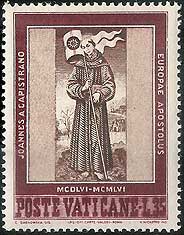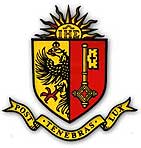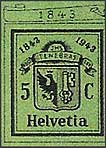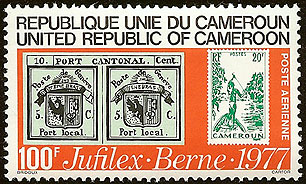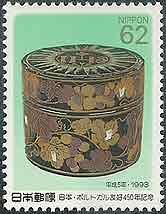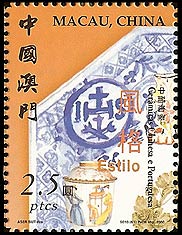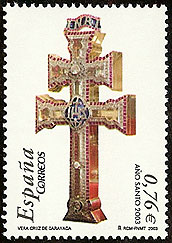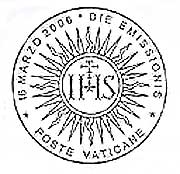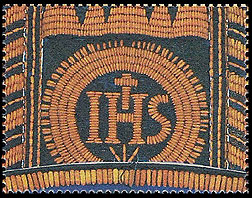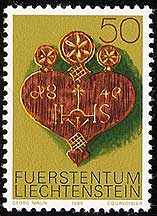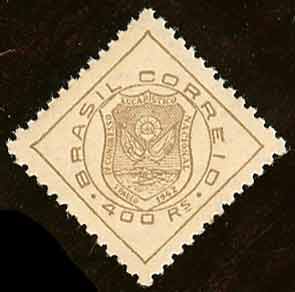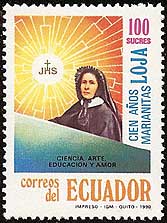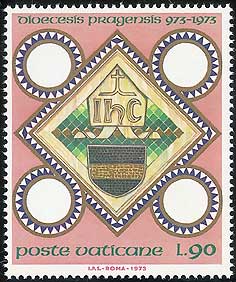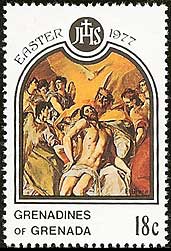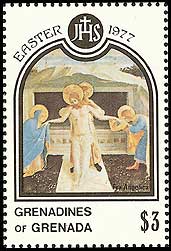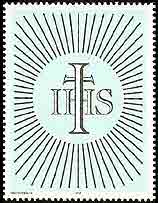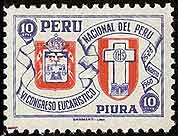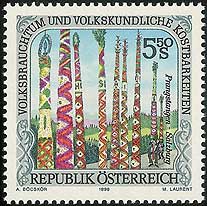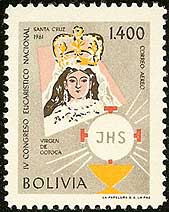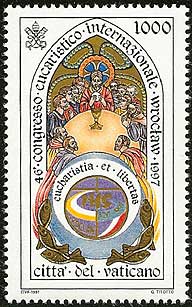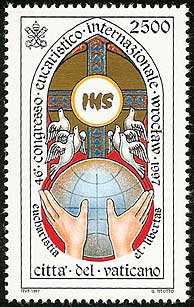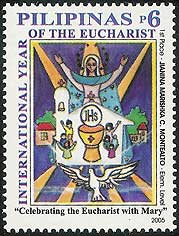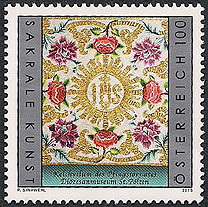Forerunners of the Jesuit Seal
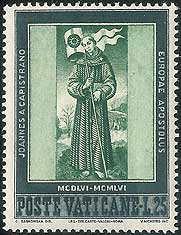
VATICAN CITY, 1956, Scott 214-215The IHS monogram used by the Jesuits is an abbreviation for the name of Jesus in Greek: IHSOUS. Originally and on many icons the final letter is the Greek form of sigma used at the end of a word, IHC, but eventually the more familiar Roman S came into use. Normally a line is drawn above the three letters (as on the crest of Geneva below) to indicate that it is an abbreviation. In northern France small Roman letters were used (ihs) and the line was drawn through the h to form a cross. Such an inscription was above the door of the College of St. Barbara at the University of Paris where Ignatius would often have seen it. When the monogram went back to capital letters, people were unwilling to loose the cross and so mounted a cross on the horizontal stroke of the H. The stamp above shows St. John Capistrano (1385-1456) preaching devotion to the name of Jesus, as did his master St. Bernardino of Siena (1380-1444) with the IHS on a banner. On the Church of St. Michael in Vilnius (below), is what looks like the seal of the Society, but it is a reference to St. Bernadino since the church was built for Bernardine (Franciscan) nuns.

USSR, 9 Feb 1976, postal stationery shows (in blue) St. Michael's Church (Museum of Architecture), Vilnius, Lithuania.
Though IHS seal is identical with that of the Jesuits, it actually refers to the Bernadine tradition of the church and attached convent.
The Geneva coat of arms, dating to the 15th century, has as its crest
a half-rising sun bearing IHS in Greek letters.

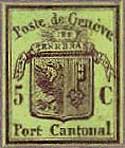
SWITZERLAND (GENEVA), 1843, Scott 2L1
SWITZERLAND (GENEVA), 1845-48, Scott 2L2-4
SWITZERLAND, 1943, centenary of postage stamps, B132The Double Geneva of Switzerland ranks as one of the world's rarest stamps. The stamp joins two 5 cent stamps and, in a rectangle above, the text 10. PORT CANTONAL. CENT. (see the Cameroon stamp below for full image). The stamps bear Geneva's coat of arms of which the crest is an IHS within a sunburst. The arms were repeated on the following and on commemorative issues. Switzerland's constitutional ban against Jesuits was repealed as recently as 1973 (by a slim majority of voters).
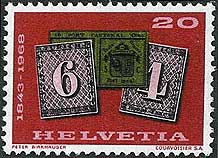
SWITZERLAND, 1968, the 125th anniversary of Swiss postage stamps, Scott 492
CAMEROON, 1977, Scott C253The Seal of the Society of Jesus:
IHS, Cross and Nails
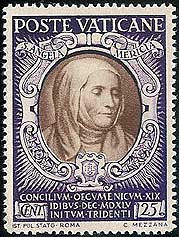

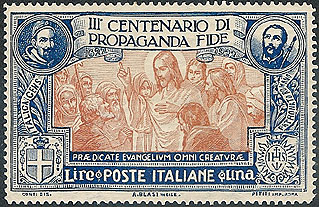
The Society of Jesus uses as its seal the IHS surmounted by a cross, three nails below,
and the whole often surrounded by sunburst. It appears on many Jesuit stamps including:
VATICAN CITY, 1946, the 4th centenary of the Council of Trent, Scott 111 and 113
ITALY, 1923, the tercentenary of the Sacred Congregation for the Propagation of the Faith, Scott 146
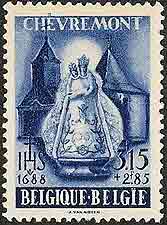

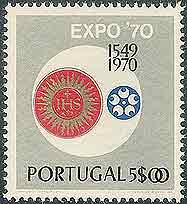
BELGIUM, 1948, it appears beside the Old English Chapel at Chevremont, Scott B453
ARGENTINA, 1964, at the top of the National University of Cordoba arms, Scott 764
PORTUGAL, 1970, on a Portuguese-Japanese commemorative stamp, Scott 1074
JAPAN, 1993, on a tea caddy or host box, Scott 2212Portugal observed Expo 1970 with symbols of Portuguese-Japanese relationship. On the rear of one stamp (above) in English, French and Portuguese is written: Evoking the introduction of Christianity to Japan, by the Portuguese. The stamp mentions the date 1549 when Jesuits first went to Japan, and includes the seal of the Society of Jesus, the IHS monogram of Jesus between cross and nails surrounded by a sunburst — the same seal embossed on the background of this website.
Japan later included in a set marking Portuguese-Japanese relations what seems to be a natsume, a tea caddy to hold the powered green tea used in the tea ceremony. Scott describes it as a mother-of-pearl box to hold wafers used at the Eucharist, and the top of it is adorned with seal of the Society of Jesus.
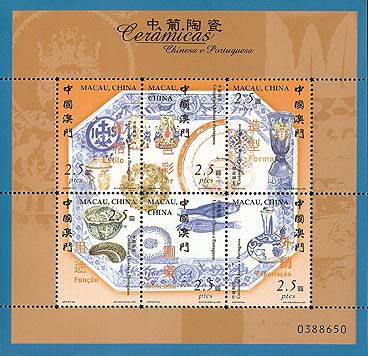
MACAO, 2000, on October 31 a mini-sheet celebrating Chinese & Portuguese Ceramics
featuring the IHS with cross and nails on the top left stamp, Scott 1037
It appears twice on this se-tenant pair honoring The Jesuit Block and the Estancias of Córdoba as well as on the title page illustrated on the label.
ARGENTINA, 2001, Scott 2160
SPAIN, 2003, the Holy Year issue, Scott 3236
The stamp shows the reliquary containing the miraculous True Cross of Caravaca with the Society's emblem

MACAO, 2006, the Society of Jesus series, Fr. Mateo Ricci holds an image of the seal;
Fr. Alessandro Valignano holds a book with the whole seal, while the IHS with cross is over his head, Scott 1205, 1207
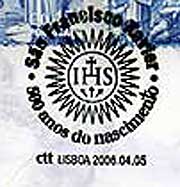
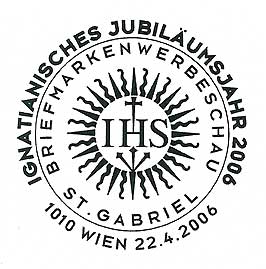
PORTUGAL, 2006, FDI cancel for the Xavier Jubilee issue
AUSTRIA, 22 April 2006, a special show cancel for the Ignatian Jubilee
used with a personalized stamp of St. Ignatius created by Mag. Wilhelm Remeš.
The cancel features the seal of the Society imaged on that stamp
VATICAN CITY, 2006, FDI cancel for the Jubilee issue
PARAGUAY, 2016, from an issue honoring touristic ambassadors showing a detail of an altar retable for use during a visit of Pope Francis.The IHS without reference to the Society
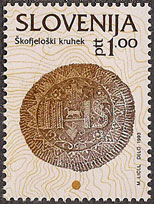

SLOVENIA, 1993, Slovenia - Europe in Miniature series, Scott 153
a traditional Slovenian honeycake. More
LIECHTENSTEIN, 1976 Christmas and 1980 a traditional cattle decoration, Scott 613, 688
The first two incorporate a heart beneath the nails, a reference to Mary's heart that suffers with Christ.
Jesuits used this form early on, but later dropped the heart and remained with the nails alone.
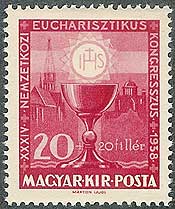
HUNGARY, 1938, 34th International Eucharistic Congress, stamp and souvenir sheet, Scott B93-94
BRAZIL, 1942, 4th National Eucharistic Congress, São Paulo, on host above chalice, Scott 539


ECUADOR, 1958, 3rd National Eucharistic Congress, Scott C330
ECUADOR, 1990, The Marianists' centenary, Scott 1239
VATICAN CITY, 1973, the millennium of the Diocese of Prague, Scott 542
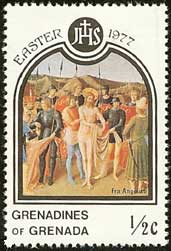
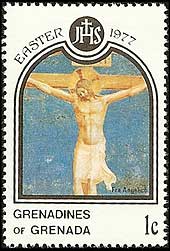
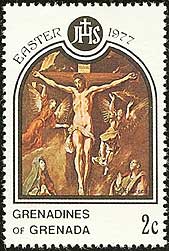

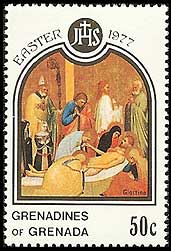
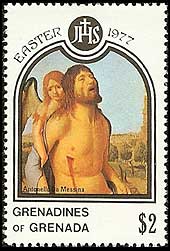
GRENADINES, 1977, Easter issue, Scott 221-228, the last from a souvenir sheet
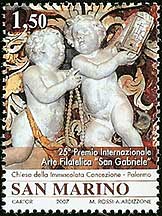
SAN MARINO, 2007, honoring the Saint Gabriel Philatelic Society, Scott 1712
marble decoration from the Church of the Immaculate Conception in Palermo: cherubs bearing the IHS and cross
San Marino was awarded for this issue the 25th St. Gabriel Award for the Best Religious Stamps.
ANDORRA (French Administration), 1997 a label between art work stamps, Scott 484a
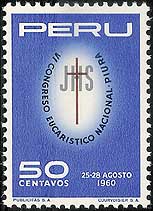
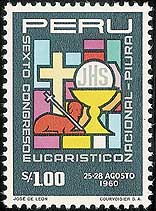
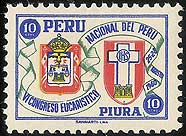
PERU, the 6th Eucharistic Congress, 1960, Scott 479-80, RA 37-38 (color differences)
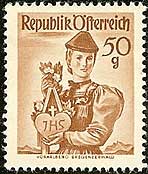
AUSTRIA, 1949, a cattle decoration like the one from Liechtenstein, Scott 531
AUSTRIA, 1996, Prangstangen (flower decorated poles) with IHS, Scott 1705
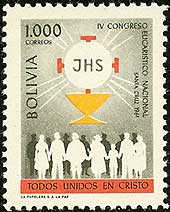
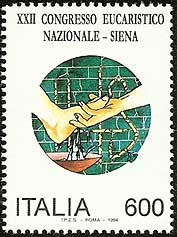
BOLIVIA, 1961, National Eucharistic Congress in Santa Cruz, Scott 453, C231
ITALY, 1994, National Eucharistic Congress in Siena, Scott 1987
